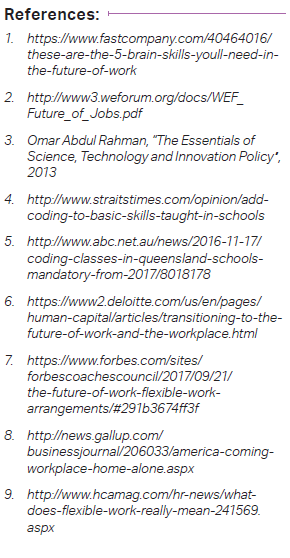by | Mohd Hasan Mohd Saaid | hasan@might.org.my
The 4th Industrial Revolution will not only bring opportunities but introduce disruption to our work, the larger workforce, as well as the workplace as we know it today. These changes are occurring at an accelerated pace due to the advancement of digital technology. Subsequently, the fast rate of innovation is fuelling the creation of new economy that clearly impacts both public and private entities.
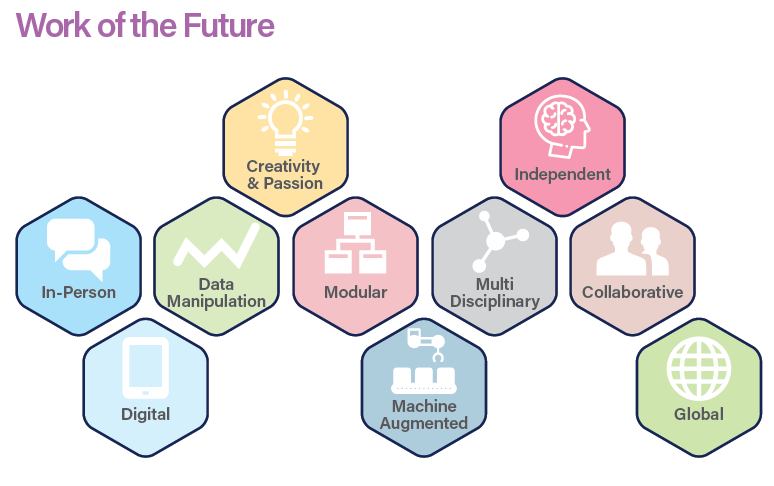
As the future evolves, the convergence of industry in current sectors becomes clear, reducing the lines of demarcation originally defined and codified almost 80 years ago. The future work is expected to be digital in nature, requiring data manipulation, and most importantly, will highly be augmented or assisted by machines.
Although AI and automation will replace many job positions, neuroscientist Tara Swart believes that positions with deep human skills covering multi-disciplinary, collaborative, independent and creative jobs are rising in job market
value. Type of jobs will become modular, which means it can be assigned individually on a global level.
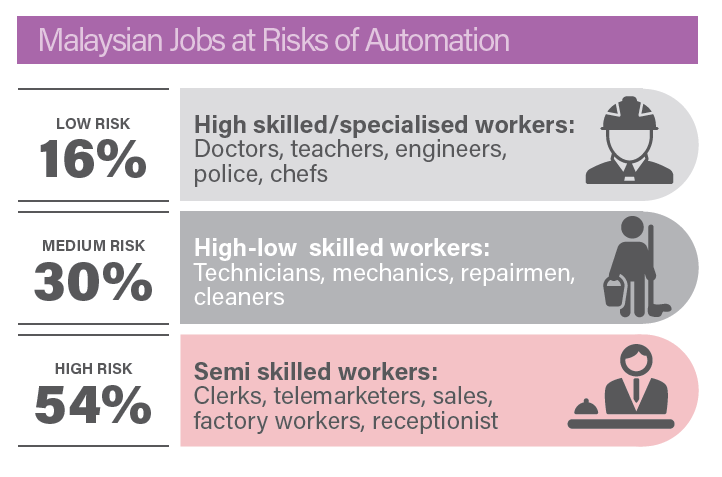
Work quality and employee productivity however, will still be the focus of future work. With modern technology, there would be higher gains in these two focus areas. The drawback to these gains is that they will be more beneficial to the employer than to the workers due to the potential of job automation by machines or robots.
The percentage of jobs at risk to be replaced by automation varies by country. An OECD survey puts the average of jobs at risk at 57 percent. In Malaysia, a MIGHT analysis classifies the risk in accordance to the worker’s skill level. 16 percent of Malaysian jobs are at low risk of automation—these include doctors, teachers, engineers, police and chefs. Meanwhile, 30 percent of Malaysian jobs at risk of automation covers technical occupations like technicians, mechanics and repairmen. Jobs for semi-skilled workers such as clerks, telemarketers, factory workers and receptionist are at 54 percent risk of automation.
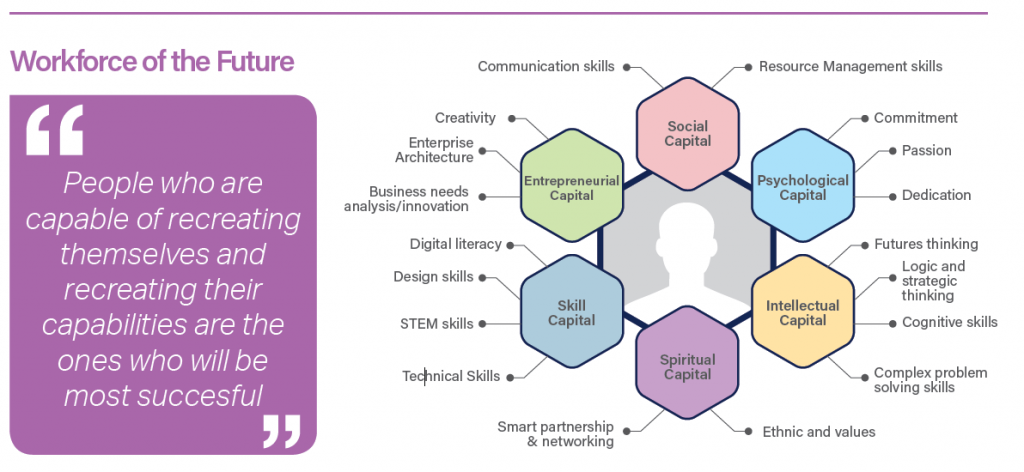
The model above depicts the type of workforce in the future, adopted from Tan Sri Omar’s book, “The Essentials of Science, Technology and Innovation Policy”. The book mentioned that an employee’s skills should include aspects of Social Capital, Psychological Capital, Intellectual Capital, Spiritual Capital, Skills Capital and Entrepreneurial Capital.
For example, Social Capital consist of communications and resource management skills. With the era of big data, data scientists should be able to manipulate and communicate important data well through data visualisation, to enable evidence based decision-making. While Intellectual Capital covers the area of future-, logic- and strategic thinking, cognitive skills as well as complex problem solving skills required in a future workforce, (as also described in WEF’s Skills of the Future).
Entrepreneurial Capital relies on the workforce monetisation of skills. Capitalising on the creativeness and innovativeness of workforce, through design-, STEM- and Technical Skills, digital literacy, along with Smart partnership and networking. Digital
literacy is a must in the future of workforce due to the nature that the backbone of The 4th Industrial Revolution is digitalisation. Computer coding is already implemented as part of the primary curriculum in England, Belgium, Finland, Estonia and the Netherlands.
In the long run, every worker’s future is dependent on the ability to continuously acquire knowledge and improve his or her skills in order to survive. It is already a known fact that in the future, the workforce can be diverted away from the 3D (dirty, dangerous, and difficult) jobs by replacing them with automation and robotics. But today, AI is already disrupting occupations that were long considered immune to technological displacement such as white-collar work and creative endeavours. As a result of this development, it is very unlikely that any employee can consider their current jobs future-proof.
While technologies replace some jobs, at the same time technology also create new work opportunities. Automation and AI will lead to collaboration between man and machine. In most cases, automation will take over specific repetitive or mundane tasks—according to a study by ServiceNow, 94 percent agreed that when repetitive tasks are automated, the demand for soft skills jobs will grow.
A popular survey from the World Economic Forum (WEF) states that 65 percent of children entering primary school today will partake in jobs that do not yet exist and for which their education will fail to prepare them. This points to the size of the challenge to mitigate skills gap and reduce unemployment in the future workforce. Since by 2025, 75 percent of the global workforce will be comprised of millennials, the workplace of the future needs to be designed with this group in mind. For instance, over 97 percent of millennials say that work-life balance in the future is important to them. The future workforce may also require higher participation from the female and aging population pool of workers as well as migrants to increase opportunities.
MIGHT Analysis further provides an overview of skills required from 12 key technology areas of the future. The 12 key technology are; Artificial Intelligence, Internet of Things (IoT), Blockchain, 3D Printings, Robotics, Advance Materials, Energy Storage, Big Data, Cloud Technology, Mobile Internet, Virtual Reality, and Drones. Some of the technologies shared the same skills required to be master.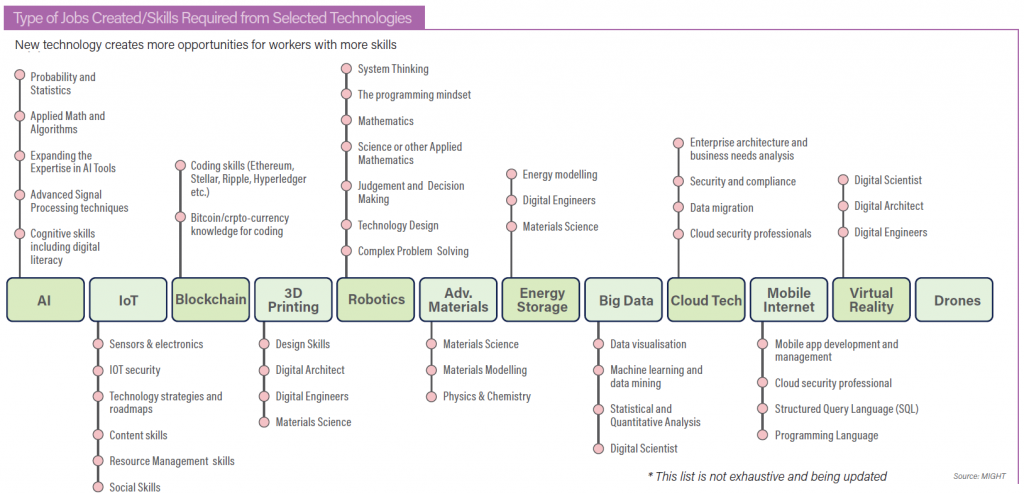

Important aspects of an ideal future workplace are Wellness, Green, Technology Driven, and Collaborative. It is no longer the physical place that define a workplace of the future, because what we can carry with us—digital devices such as mobile phone, laptops and tablets—to get the job done, matters more.
Wellness
Wellness represent the internal element of workforce where inclusion and flexibility contributes to the overall harmonisation of a workplace. Over the past decade, employers have come to understand the importance of physical well being and its effect on the happiness and productivity of employees. A flexible work arrangement may be in the form of telecommuting and/or part-time schedule will no longer be a negotiating strategy or job perk but an expected job benefit. Trends show that more employees enjoy flexible work with evidence from Gallup survey showing 43 percent of American workers working remotely at least part of the time as of 2016.
Green
Environmental friendly and sustainable working environment in the future of workplace will involve both employers and employees to apply change. Workplace will be very focused on sustainability, well-being, and eco-living. Organisations will no longer be focusing on revenues and market shares, but instead believe that they are making a difference in the world as well as imposing positive social and environmental impact. The workplace will invest heavily in collaboration technology and conferencing solutions to avoid employees from having to travel and subsequently reducing carbon foot print.
Collaborative
Workplace of the future will be a place where culture and humanity co-exist as business leaders will prioritise in creating a balanced place of work. To achieve this,
organisations must be better equipped at understanding and developing their workforce management skills.
In the freelance economy (gig economy), professionals can participate in digital marketplaces to secure a greater volume of assignments, promote marketing, practice secure payment systems and vet potential clients. A study exploring the gig economy found that 93 percent of companies imagined a future blended workforce as they see freelance workers teaming up with employees to work on projects together.
Co-creation is also heavily embraced as organisations team up with customers, partners, employees and other constituents to develop products and services. The structure of organisations needs to reflect the changing nature of work.
Organisations should seek ways to flatten the hierarchy, making jobs more dynamic, and further leverage on contingent and contract labor in the future.
Technology Driven
It is imperative for a workplace to be technology driven as it is the main enabler for work to be done productively. Any industry related services will require digital platform as a medium to interact with clients. Workplace designs need to incorporate new trends such as mobility and application of new technology that will enable workers to deliver their work effectively and autonomous vehicles in the future may even be used not only for commuting but as a mobile office. For example, Global design consultancy IDEO has developed a series of concept vehicles that imagines how autonomous vehicles could transform the way we work. Augmented Reality (AR) or Virtual Reality (VR) is also an example that work can be done without needing specific workstations.
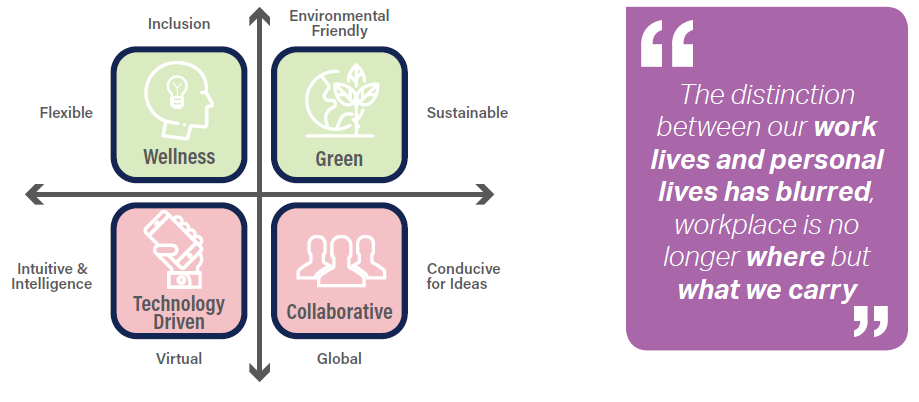
Conclusion
While uncertainties exist with regards to the impact of automation and AI in the future of work, exploring futures scenarios enables stakeholders to understand its impact toward their specific areas and to anticipate ways to cushion its impact. Governments can play a bigger role and provide supporting policies in managing
ethics if social security issues like mass unemployment due to automation and AI materialise.
If self-driving taxis are to become a reality in the upcoming years, the displacement of current taxi services is an issue we need to address with the utmost urgency. The actions we will be taking in the taxi industry should already be a wakeup call that everyone is not left unaffected by the coming 4th Industrial Revolution. This utmost concern applies across the manufacturing industries to ponder on the uncertainty of their future. The question is, what will the future holds for you and your next generation?
